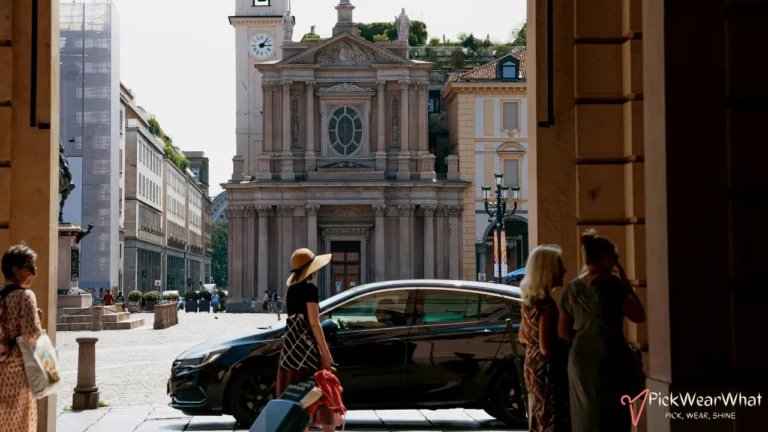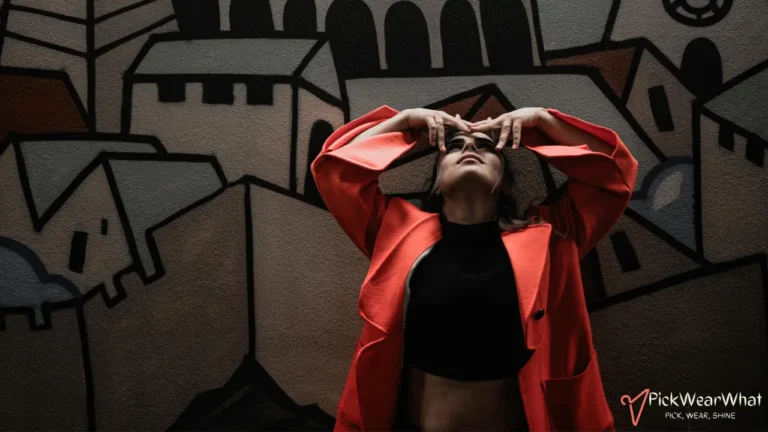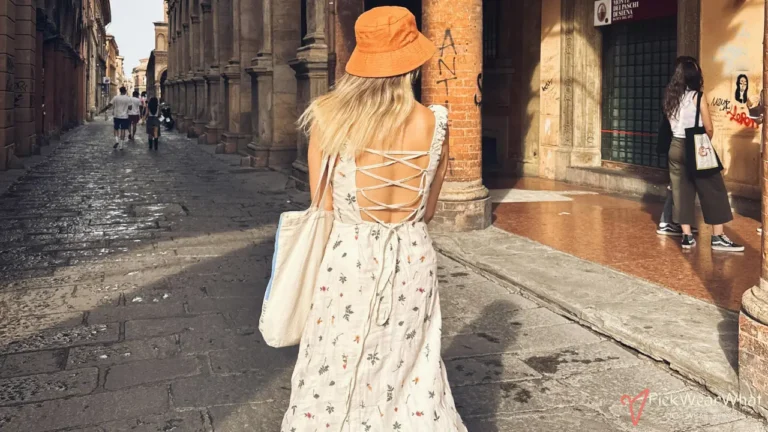When visiting churches in Portugal, both men and women should dress respectfully while adapting to the country’s four distinct seasons. In spring, choose light layers such as modest dresses or tailored suits paired with comfortable shoes. Summer calls for breathable fabrics like linen and cotton, ensuring shoulders and knees remain covered with stylish yet cool attire.
As autumn approaches, incorporate warm sweaters, jackets, and closed-toe footwear to stay comfortable during cooler days. During the winter months, opt for heavy coats, scarves, gloves, and sturdy shoes to navigate the chilly weather while maintaining a respectful appearance. By selecting appropriate seasonal clothing, you honor the sacred spaces and blend seamlessly with Portugal’s cultural and climatic landscape.
Understanding Portuguese Church Etiquette
Portugal is predominantly a Catholic country, and its churches are not only places of worship but also architectural marvels rich in history and art. When visiting these sacred spaces, it’s essential to adhere to local customs and dress codes to show respect to both the religious practices and the community.
Key Points:
- Respect and Modesty: Dress modestly to honor the sanctity of the church. Avoid overly casual or revealing clothing.
- Cultural Sensitivity: Recognize that churches are places for prayer and reflection. Dressing appropriately helps maintain a solemn atmosphere.
- Seasonal Considerations: Portugal experiences varied weather; dress accordingly while ensuring adherence to modesty standards.
General Guidelines for Church Attire in Portugal
Before delving into specific attire for men and women, here are some general guidelines applicable to all visitors:
- Coverage: Shoulders and knees should be covered. Avoid sleeveless tops and short skirts or shorts.
- Avoiding Casual Wear: Refrain from wearing beachwear, sports jerseys, or excessively casual clothing like tank tops and flip-flops.
- Color Choices: While bright colors are not forbidden, opting for more subdued tones can be more respectful and appropriate.
- Head Coverings: Generally not required for visitors, but women may choose to cover their heads as a sign of respect if they prefer.
What Should Women Wear To Church in Portugal?
Women attending churches in Portugal should wear modest attire, such as knee-length dresses or skirts with covered shoulders and appropriate footwear to honor local customs.
Dresses and Skirts
When selecting dresses or skirts for visiting Portuguese churches:
- Length: Dresses and skirts should ideally extend below the knee. Maxi skirts or dresses are a safe choice.
- Style: Opt for modest cuts that avoid being too tight or revealing. A-line or wrap dresses are both stylish and respectful.
- Fabric: Choose comfortable fabrics suitable for the weather. Lightweight materials like cotton or linen are great for warmer months, while thicker fabrics like wool are better for cooler seasons.
Tops and Blouses
- Sleeves: Tops should have sleeves that cover the shoulders. If wearing sleeveless tops, pair them with a cardigan or a shawl.
- Necklines: Avoid plunging necklines. Higher necklines or those with subtle detailing are appropriate.
- Patterns and Colors: While patterns are acceptable, avoid overly flashy or distracting designs. Solid colors or subtle patterns work best.
Accessories
- Scarves and Shawls: These are useful for covering shoulders or heads if needed and add a touch of elegance to your outfit.
- Jewelry: Keep it minimal and tasteful. Avoid large or noisy jewelry that might be distracting.
- Bags: Opt for small to medium-sized bags that are easy to carry and don’t draw excessive attention.
Footwear
- Comfort and Modesty: Closed-toe shoes are preferable, especially in historical churches where floors may be uneven.
- Style: Flats, low heels, or modest sandals are appropriate. Avoid overly casual shoes like flip-flops or sneakers unless styled appropriately.
- Color Coordination: Neutral colors like black, brown, or navy complement most outfits and maintain a respectful appearance.
What Should Men Wear To Church in Portugal?
Men visiting churches in Portugal should dress in collared shirts, long pants, and closed-toe shoes to ensure respectful and appropriate attire.
Shirts and Tops
- Collared Shirts: A collared shirt or polo is ideal. For a more formal setting, a button-down shirt is recommended.
- Sleeves: Long sleeves are preferable, especially in traditional or more formal churches. If wearing short sleeves, ensure they cover the shoulders adequately.
- Layers: In cooler weather, layering with a lightweight sweater or a blazer can enhance your look while maintaining appropriateness.
Trousers and Jeans
- Trousers: Chinos or dress trousers in neutral colors like black, navy, or beige are excellent choices.
- Jeans: Dark, well-fitted jeans without excessive distressing can be acceptable in less formal churches. Avoid overly casual or ripped jeans.
- Length: Ensure trousers are hemmed to an appropriate length, just touching the shoes without pooling.
Accessories
- Belts: A quality leather belt that matches your shoes can add a polished touch to your outfit.
- Watches and Minimal Jewelry: Simple accessories like a wristwatch or a subtle bracelet are appropriate. Avoid flashy or large pieces.
- Hats: Generally not necessary unless it’s part of your personal or cultural attire. If you choose to wear a hat, ensure it is respectful and not overly casual.
Footwear
- Style: Opt for closed-toe shoes such as loafers, oxfords, or clean sneakers in neutral colors.
- Comfort: Choose comfortable shoes, especially if you plan to explore large or historic churches where you might be standing or walking for extended periods.
- Condition: Ensure shoes are clean and in good condition to maintain a respectful appearance.
What to Wear to Churches in Portugal by Month?
Discover the perfect attire for every season with a month-by-month guide on what to wear to churches in Portugal, blending respect for tradition with comfort and style.
| Month | Weather Overview | Women’s Attire | Men’s Attire |
|---|---|---|---|
| January | Cold (8°C – 15°C), frequent rain | – Long-sleeved blouses or sweaters – Long skirts or pants with tights – Warm waterproof coat – Scarves and gloves – Waterproof boots | – Long-sleeved shirts or thermal layers – Wool trousers or jeans – Heavy waterproof coat – Scarves and gloves – Waterproof boots |
| February | Cold (8°C – 15°C), gradual temperature rise, rain continues | – Layered sweaters or cardigans over blouses – Long skirts or pants with thermal layers – Waterproof coat – Scarves, gloves, and hats – Waterproof boots | – Layered shirts with sweaters or jackets – Wool trousers or jeans with thermal layers – Waterproof coat – Scarves and gloves – Waterproof boots |
| March | Spring begins (10°C – 18°C), decreasing rain | – Light sweaters or blouses – Midi skirts or lightweight trousers – Medium-weight coat or waterproof jacket – Light scarves – Closed-toe shoes or ankle boots | – Long-sleeved shirts or lightweight sweaters – Chinos or jeans – Medium-weight jacket or trench coat – Light scarves – Closed-toe shoes or loafers |
| April | Warmer spring (12°C – 20°C), more sunny days | – Blouses or lightweight sweaters – Knee-length skirts or dresses with layers – Light jackets or trench coats – Scarves and hats – Closed-toe flats or low heels | – Long-sleeved or polo shirts – Chinos or lightweight trousers – Light jackets or blazers – Lightweight scarves – Closed-toe shoes or loafers |
| May | Pleasant spring (15°C – 23°C), less rain | – Light blouses or tunics – Midi skirts or tailored trousers – Light cardigan or blazer – Minimal scarves and stylish hats – Closed-toe flats or low heels | – Lightweight long-sleeved or polo shirts – Chinos or lightweight trousers – Light blazers or cardigans – Minimalist belts and wristwatches – Loafers or clean sneakers |
| June | Start of summer (18°C – 28°C), generally warm and dry | – Sleeveless blouses with cardigans or shawls – Knee-length skirts or lightweight dresses – Light shawl or cardigan – Light scarves and sun hats – Comfortable closed-toe sandals or flats | – Short-sleeved button-down or polo shirts – Chinos or lightweight trousers – Lightweight blazer or cardigan – Minimalist belts – Loafers or comfortable closed-toe sandals |
| July | Hot (20°C – 30°C), coastal areas cooler | – Lightweight, breathable blouses or dresses – Knee-length skirts or dresses – Lightweight cardigan or shawl – Sun hats and minimal scarves – Comfortable closed-toe sandals or flats | – Short-sleeved button-downs or breathable polo shirts – Chinos or lightweight trousers – Light blazer or cardigan – Minimalist belts and sunglasses – Loafers or comfortable sandals |
| August | Continued summer heat (20°C – 30°C), coastal breezes | – Breathable blouses or sleeveless dresses with shawl/cardigan – Lightweight skirts or dresses – Light shawl or cardigan – Sun hats and lightweight scarves – Closed-toe sandals or comfortable walking shoes | – Short-sleeved shirts or polo shirts – Chinos or lightweight trousers – Light cardigan or blazer – Minimalist belts and sun protection accessories – Loafers or clean sneakers |
| September | Transition to autumn (17°C – 26°C), cooling down | – Long-sleeved blouses or lightweight sweaters – Midi skirts or layered dresses – Light jacket or cardigan – Light scarves – Closed-toe flats or loafers | – Long-sleeved shirts or lightweight sweaters – Chinos or dark jeans – Light jackets or blazers – Minimalist belts and wristwatches – Loafers or clean sneakers |
| October | Cooler autumn (14°C – 22°C), increased rain | – Long-sleeved blouses or sweaters – Knee-length skirts or layered dresses – Waterproof jackets or trench coats – Scarves and umbrellas – Closed-toe boots or waterproof shoes | – Long-sleeved shirts or sweaters – Chinos or tailored trousers – Waterproof jackets or trench coats – Scarves and umbrellas – Waterproof boots or sturdy closed-toe shoes |
| November | Cool (11°C – 18°C), high rainfall | – Sweaters or thermal tops – Long skirts or wool trousers – Heavy waterproof coats – Scarves, gloves, and hats – Waterproof boots | – Long-sleeved shirts or thermal layers – Wool trousers or dark jeans – Heavy waterproof coats – Scarves and gloves – Waterproof boots or sturdy shoes |
| December | Chilly (8°C – 15°C), common rain and fog | – Warm sweaters and thermal tops – Long skirts or dresses with thermal layers – Heavy waterproof coats – Scarves, gloves, and hats – Waterproof boots | – Long-sleeved shirts and thermal layers – Wool trousers or dark jeans – Heavy waterproof coats – Scarves and gloves – Waterproof boots or sturdy shoes |
January
January is one of the coldest months in Portugal, with average temperatures ranging from 8°C (46°F) in the north to 15°C (59°F) in the south. Rainfall is common, especially in northern regions.
For Women:
- Tops: Long-sleeved blouses or sweaters made from wool or thermal materials.
- Bottoms: Long skirts or pants; consider layering with tights for added warmth.
- Outerwear: A warm coat, preferably waterproof to handle rain.
- Accessories: Scarves and gloves to stay warm.
- Footwear: Closed-toe, waterproof boots or sturdy shoes.
For Men:
- Tops: Long-sleeved shirts or thermal shirts layered with sweaters.
- Bottoms: Wool trousers or jeans; layering with thermal leggings can add warmth.
- Outerwear: A heavy coat, ideally waterproof.
- Accessories: Scarves and gloves.
- Footwear: Waterproof boots or sturdy closed-toe shoes.
February
Similar to January, February remains chilly with occasional rainfall. Temperatures gradually start to rise towards the end of the month.
For Women:
- Tops: Layered clothing with sweaters or cardigans over blouses.
- Bottoms: Long skirts or pants with thermal layers.
- Outerwear: Warm, waterproof coats.
- Accessories: Scarves, gloves, and hats.
- Footwear: Waterproof boots or durable shoes.
For Men:
- Tops: Layered shirts with sweaters or jackets.
- Bottoms: Wool trousers or jeans with thermal layers.
- Outerwear: Waterproof coats.
- Accessories: Scarves and gloves.
- Footwear: Waterproof boots or sturdy shoes.
March
March marks the beginning of spring with milder temperatures ranging from 10°C (50°F) to 18°C (64°F). Rainfall decreases as the month progresses.
For Women:
- Tops: Light sweaters, blouses, and long-sleeved shirts.
- Bottoms: Midi skirts, long pants, or lightweight trousers.
- Outerwear: A medium-weight coat or a waterproof jacket.
- Accessories: Light scarves and umbrellas.
- Footwear: Closed-toe shoes or ankle boots.
For Men:
- Tops: Long-sleeved shirts or lightweight sweaters.
- Bottoms: Chinos or jeans with lightweight layers.
- Outerwear: Medium-weight jackets or trench coats.
- Accessories: Light scarves and umbrellas.
- Footwear: Closed-toe shoes or loafers.
April
Spring continues with warmer temperatures, typically between 12°C (54°F) and 20°C (68°F). Showers are still possible, but sunny days become more frequent.
For Women:
- Tops: Blouses, lightweight sweaters, or long-sleeved tops.
- Bottoms: Knee-length skirts, dresses with layers, or lightweight trousers.
- Outerwear: Light jackets or trench coats.
- Accessories: Scarves and hats for variable weather.
- Footwear: Closed-toe flats, loafers, or low-heeled shoes.
For Men:
- Tops: Long-sleeved shirts, polo shirts, or lightweight sweaters.
- Bottoms: Chinos, lightweight trousers, or dark jeans.
- Outerwear: Light jackets or blazers.
- Accessories: Lightweight scarves if needed.
- Footwear: Closed-toe shoes or loafers.
May
May ushers in pleasant spring weather with temperatures ranging from 15°C (59°F) to 23°C (73°F). Rain is less frequent, and days are longer.
For Women:
- Tops: Light blouses, tunics, or lightweight sweaters.
- Bottoms: Midi skirts, dresses with light layers, or tailored trousers.
- Outerwear: A light cardigan or blazer for cooler mornings and evenings.
- Accessories: Minimal scarves and stylish hats.
- Footwear: Closed-toe flats, low heels, or comfortable sandals.
For Men:
- Tops: Lightweight long-sleeved shirts or polo shirts.
- Bottoms: Chinos, tailored shorts (if appropriate), or lightweight trousers.
- Outerwear: Light blazers or cardigans.
- Accessories: Minimalist belts and wristwatches.
- Footwear: Loafers, brogues, or clean sneakers.
June
June brings the start of summer with temperatures ranging from 18°C (64°F) to 28°C (82°F). It’s generally warm and dry, especially in southern regions.
For Women:
- Tops: Sleeveless blouses paired with cardigans or shawls for covering shoulders.
- Bottoms: Knee-length skirts, lightweight dresses, or tailored shorts if modesty is maintained.
- Outerwear: A light shawl or cardigan for air-conditioned churches.
- Accessories: Light scarves and sun hats.
- Footwear: Comfortable closed-toe sandals or flats; avoid flip-flops.
For Men:
- Tops: Short-sleeved button-down shirts or polo shirts; consider lightweight fabrics.
- Bottoms: Chinos or lightweight trousers; tailored shorts can be appropriate if not too casual.
- Outerwear: A lightweight blazer or cardigan for air-conditioned interiors.
- Accessories: Minimalist belts and sunglasses for outdoor attire.
- Footwear: Loafers, clean sneakers, or comfortable closed-toe sandals.
July
July is one of the hottest months in Portugal, with temperatures soaring between 20°C (68°F) and 30°C (86°F). Coastal areas are more temperate compared to inland regions.
For Women:
- Tops: Lightweight, breathable blouses or dresses; consider sleeveless options with a shawl.
- Bottoms: Knee-length skirts or dresses; lightweight trousers for greater coverage.
- Outerwear: A lightweight cardigan or shawl for indoor areas.
- Accessories: Sun hats and minimal scarves.
- Footwear: Comfortable closed-toe sandals or breathable flats.
For Men:
- Tops: Short-sleeved button-downs or breathable polo shirts.
- Bottoms: Chinos or lightweight trousers; tailored shorts can be acceptable if modest.
- Outerwear: A light blazer or cardigan for indoor comfort.
- Accessories: Minimalist belts and sunglasses.
- Footwear: Loafers, clean sneakers, or comfortable sandals.
August
August continues the summer heat with temperatures similar to July. Coastal regions offer some respite with cooler breezes.
For Women:
- Tops: Breathable blouses or sleeveless dresses paired with a shawl or cardigan.
- Bottoms: Lightweight skirts or dresses; ensure modesty with appropriate lengths.
- Outerwear: A light shawl or cardigan for air-conditioned interiors.
- Accessories: Sun hats and lightweight scarves.
- Footwear: Closed-toe sandals, breathable flats, or comfortable walking shoes.
For Men:
- Tops: Short-sleeved shirts or polo shirts in lightweight fabrics.
- Bottoms: Chinos or lightweight trousers; tailored shorts are acceptable if modest.
- Outerwear: A light cardigan or blazer for indoor comfort.
- Accessories: Minimalist belts and sun protection accessories like hats.
- Footwear: Loafers, clean sneakers, or comfortable sandals.
September
September marks the transition from summer to autumn, with temperatures ranging from 17°C (63°F) to 26°C (79°F). The weather remains warm but starts to cool down towards the end of the month.
For Women:
- Tops: Long-sleeved blouses or lightweight sweaters.
- Bottoms: Midi skirts, dresses with layers, or lightweight trousers.
- Outerwear: A light jacket or cardigan for cooler evenings.
- Accessories: Light scarves and minimal jewelry.
- Footwear: Closed-toe flats, loafers, or comfortable low heels.
For Men:
- Tops: Long-sleeved shirts or lightweight sweaters.
- Bottoms: Chinos, lightweight trousers, or dark jeans.
- Outerwear: Light jackets or blazers for layering.
- Accessories: Minimalist belts and wristwatches.
- Footwear: Loafers, brogues, or clean sneakers.
October
October brings cooler temperatures ranging from 14°C (57°F) to 22°C (72°F). Rain becomes more frequent as autumn progresses.
For Women:
- Tops: Long-sleeved blouses, sweaters, or layered tops.
- Bottoms: Knee-length skirts, dresses with layers, or tailored trousers.
- Outerwear: Waterproof jackets or trench coats.
- Accessories: Scarves and umbrellas to handle rain.
- Footwear: Closed-toe boots or waterproof shoes.
For Men:
- Tops: Long-sleeved shirts, sweaters, or light jackets.
- Bottoms: Chinos, tailored trousers, or dark jeans.
- Outerwear: Waterproof jackets or trench coats.
- Accessories: Scarves and umbrellas.
- Footwear: Waterproof boots or sturdy closed-toe shoes.
November
November is characterized by cooler temperatures between 11°C (52°F) and 18°C (64°F), with increased rainfall across Portugal.
For Women:
- Tops: Sweaters, long-sleeved blouses, and thermal tops.
- Bottoms: Long skirts, dresses with warm layers, or wool trousers.
- Outerwear: Heavy coats or waterproof jackets.
- Accessories: Scarves, gloves, and hats to stay warm.
- Footwear: Waterproof boots or sturdy closed-toe shoes.
For Men:
- Tops: Long-sleeved shirts, sweaters, or thermal layers.
- Bottoms: Wool trousers or dark jeans with thermal layers.
- Outerwear: Heavy coats or waterproof jackets.
- Accessories: Scarves and gloves.
- Footwear: Waterproof boots or sturdy closed-toe shoes.
December
December is another chilly month with temperatures ranging from 8°C (46°F) to 15°C (59°F). Rain is common, and some regions may experience fog.
For Women:
- Tops: Warm sweaters, long-sleeved blouses, and thermal tops.
- Bottoms: Long skirts or dresses with thermal layers, wool trousers.
- Outerwear: Heavy, waterproof coats.
- Accessories: Scarves, gloves, and hats for added warmth.
- Footwear: Waterproof boots or sturdy closed-toe shoes.
For Men:
- Tops: Long-sleeved shirts, sweaters, and thermal layers.
- Bottoms: Wool trousers or dark jeans with thermal layers.
- Outerwear: Heavy, waterproof coats.
- Accessories: Scarves and gloves.
- Footwear: Waterproof boots or sturdy closed-toe shoes.
Additional Tips for Visiting Churches in Portugal
- Check for Dress Codes: Some churches may have specific dress codes, especially during religious ceremonies or events. It’s advisable to check in advance if you’re attending a particular service.
- Cover Tattoos and Piercings: If possible, cover visible tattoos or avoid excessive piercings to maintain decorum.
- Respectful Behavior: Besides attire, maintain respectful behavior by speaking softly, avoiding disruptive actions, and following any specific guidelines provided by the church.
- Photography: Some churches may restrict photography, especially during services. Always ask for permission or look for signage indicating photography rules.
- Weather Considerations: Portugal’s weather can vary; consider bringing layers or appropriate outerwear to stay comfortable without compromising on modesty.




